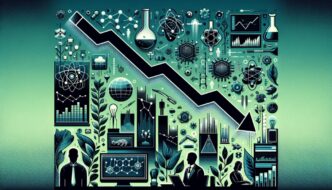The U.S. economy has once again captured attention as the Labor Department released its latest report on producer prices, revealing a surprising spike in November. As inflation continues to be a hot topic, understanding these movements is critical for consumers and investors alike. In this article, we’ll break down the details of the report, analyze its implications, and explore what it could mean for the U.S. economy as a whole.
The Breaking Report: What the Numbers Reveal
On Thursday, the Labor Department announced that the Producer Price Index (PPI) for final demand increased by 0.4 percent in November, following a revised increase of 0.3 percent in October. Economists had anticipated a more modest rise of only 0.2 percent.
Key Metrics from the Report
| Month | PPI Increase (%) | Expected Increase (%) |
|---|---|---|
| October | 0.3% | 0.2% |
| November | 0.4% | 0.2% |
These figures highlight that producer price growth is not only accelerating but doing so at a rate greater than industry expectations, sparking conversations about inflation and its broader economic ramifications.
Understanding Producer Prices and Their Significance
The Producer Price Index tracks changes in prices that producers receive for their products. It is a leading indicator of consumer inflation since businesses often pass on cost increases to consumers. Hence, understanding PPI trends can help predict future consumer price movements.
Current Implications for Inflation
To assess the impact of the November surge in producer prices, it’s important to consider how this uptick in costs might translate into higher consumer prices. Economists are closely monitoring how these inflationary pressures will affect spending patterns and overall economic growth.
Market analysts suggest that a sustained increase in producer prices could lead to:
- Increased consumer prices for goods and services
- Decelerating consumer spending as households face higher costs
- Adjustments in Federal Reserve interest rate policy based on persisting inflationary pressures
What This Means for Consumers
For the average consumer, the implications of rising producer prices are profound. With prices potentially climbing, consumers might need to brace for:
- Increased Costs: Essential goods such as food and energy are likely to feel the impact. According to recent surveys, basic grocery items may see price hikes.
- Budget Reevaluation: Households may need to reevaluate their budgets, prioritizing essential spending over discretionary items.
- Impact on Savings: Rising prices may deter consumers from saving more, as more of their income may go toward maintaining their current standard of living.
Strategies for Consumers to Mitigate Rising Costs
In light of increasing prices, consumers can adopt several strategies to manage their finances:
- Create a Flexible Budget: Allow for variations in expenses and plan for potential price increases.
- Monitor Sales and Discounts: Being more vigilant about promotions can help offset higher prices.
- Prioritize Essential Purchases: Focus on purchasing necessary items first before spending on non-essentials to manage finances better.
What Investors Need to Know
As producer prices surge, investors must stay informed to make more educated decisions. Here’s how the current economic climate might affect various investment classes:
- Fixed-Income Investments: Rising inflation typically results in higher interest rates, which can lead to declining prices for bonds. Investors in fixed-income instruments should tread carefully.
- Equities: Sectors such as consumer staples and utilities may perform better in inflationary periods. Conversely, growth stocks may struggle as higher costs reduce profit margins.
- Real Assets: Real estate and commodities can act as hedges against inflation. Investing in these assets may provide better returns in an inflationary environment.
Market Strategies for Investors
Here are some strategies to consider:
- Diversify Investments: Spread investments across various asset classes to mitigate risk.
- Focus on Dividend-Paying Stocks: Companies that pay dividends can provide a steady income, which can be beneficial in inflationary periods.
- Explore Inflation-Protected Securities: Consider Treasury Inflation-Protected Securities (TIPS) or similar instruments designed to guard against inflation risk.
Future Trends to Watch
As we move forward, several key indicators will be crucial in assessing the ongoing economic landscape:
- Federal Reserve Policy Changes: Watch for signals from the Federal Reserve regarding interest rate changes, as they may respond to persistent inflation by tightening monetary policy.
- Consumer Sentiment: Keep an eye on consumer spending patterns and sentiment, as these factors will heavily influence economic growth.
- Global Economic Conditions: Inflation does not operate in a vacuum; global trends, supply chain challenges, and geopolitical events could also impact inflation and producer prices.
Conclusion
The recent surge in producer prices beyond expectations underscores the complexity of the current economic environment in the U.S. As inflation remains a pressing concern for consumers and investors alike, understanding the nuances of these shifts is crucial. By keeping informed and adopting prudent financial strategies, households and investors can better navigate the potential challenges and opportunities that lie ahead in the evolving economic landscape.






